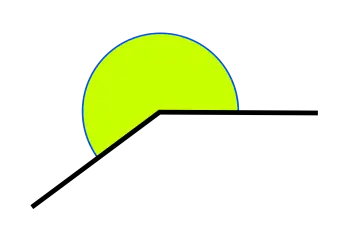
In this article, you will discover everything you need to know about concave angles, their definition and the characteristics of this element of geometry.
This definition of concave angle corresponds to the classification of angles according to their angle. According to this classification, the types of angles can be:
- Flat angles (180 degrees)
- Convex angle (less than 180 degrees)
- Concave angle (more than 180 degrees)
- Full angle (360 degrees)
What is a concave angle?
A concave angle is a type of angle that is defined by its opening. The essential characteristic to form a concave angle is that it measures more than 180°.
These types of angles can also be called incoming angles or reflex angles.
How long is a concave angle?
A concave angle measures more than 180º or π rad (PI radians) and less than 360º or 2π rad.
It is measured in degrees by the length of its arc. A concave angle can never be acute, it is always obtuse because it always measures more than 90 degrees.
Acute angles are those that measure less than 90 degrees.
Characteristics of a concave angle
The main characteristics that define this type of angles are:
- They have more than 180 degrees or PI radians, so visually it has an open shape.
- A concave angle cannot have a complement. The sum of the complementary angles must add up to 90, so due to the definition of this type of angle this condition cannot be fulfilled.
- In a regular polygon, all the external angles of the geometric figure are concave and the interior angles are convex.
- These angles cannot have an adjacent angle. Two adjacent angles must add up to 180º, a condition that cannot be met because the first angle already measures more than 180.
Difference between a concave and convex angle
The difference between a convex angle and a concave angle is determined by the opening angle. In the case of the convex angle, the angle is always less than 180 degrees while concave angles measure more than 180 degrees.
When the ends of two segments coincide at a point, two angles are formed, one concave and one convex on the other side.
Examples of in geometric figures
Concave geometric figures are those that have at least one interior angle measuring more than 180 degrees. In other words, in a concave figure, at least one vertex points inward. This implies that the figure 'folds inward,' creating at least one concave angle instead of all angles being strictly convex (less than 180 degrees).
Let's look at some examples of geometric figures that have one or more concave angles:
- Concave Triangle: A concave triangle is a type of triangle that has at least one internal angle greater than 180 degrees. This means that the triangle "folds inward" rather than maintaining a conventional shape. The vertex of the concave angle lies on the opposite side of the line segment connecting the other two vertices.
- Star polygon: The outer points of a star polygon form concave angles. Each vertex of this polygon is connected to the others by lines that form concave angles. This configuration is common in decorative symbols and ornaments.
- Arc of a circle that covers more than half the circumference: This arc forms a concave angle in the center of the circle. Arcs of this type are used in pie charts and data representations.
- Rhombus with an internal angle greater than 180 degrees: A rhombus with an internal angle that exceeds 180 degrees. Properties: The vertex of the concave angle is opposite the longest side of the rhombus. This type of rhombus can arise in the design of jewelry and decorative elements.